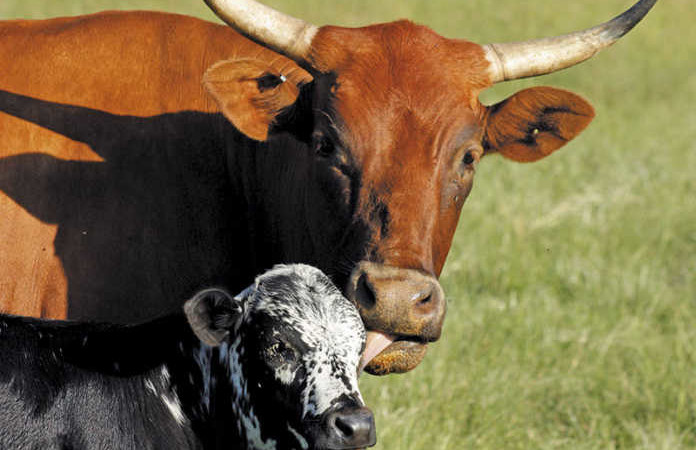

Four stomachs.
Cows are amazing animals, able to take in copious amounts of plant matter and digest it. They are able to do this because they are ruminants. They have a single stomach with four compartments. Each part of their stomach has a specific purpose. Taken together, the stomach of a cow can break down fibrous plant matter and turn it into beef or milk.
The first stomach is called the rumen. It is an enormous compartment that is something like a fermentation vat. The warmth, acidity, and mixing allows microbes in the rumen to break down the cellulose plant fibers. The cow belches up small wads of cellulose and re-chews it to help break it down. This is called chewing the cud. After the cow chews her cud, she swallows the wad and it goes to the reticulum, the smallest stomach compartment. This place is called the “honeycomb” portion of the stomach and here the food is broken down further. In the next section, the omasum, the food is mixed with acids and water. Finally the cows’ food goes to the abomasum where digestion finally occurs. The abomasum operates like the human stomach.
Bulls have horns. The cows do not.
Did you know that a cow can have horns and a bull can be without horns? Whether a cow or bull has horns or not is a function of its breed rather than its gender. Some breeds of cattle have horns. In horned animals, both male and female will be horned. Other breeds are polled, meaning they are hornless. Both bulls and cows will be polled in these breeds. Many common dairy breeds like Holstein, Jersey, and Brown Swiss have horns. Common beef breeds that are polled are Angus, Belted Galloway, Brangus. Some breeds have polled and horned varieties, like Hereford or Charolais. Sometimes the farmer will remove a horned cow’s horns for safety.
Cattle hate the color red.
This myth has been around due to the Spanish matadors waving red capes in the faces of angry bulls. However, cattle cannot see the color red at all. What makes a bull mad, aside from the fact that many bulls are just aggressive and grumpy, is having something flapping in their faces and being teased.
Cows Bite
Cows do not have teeth on the top in the fronts of their mouths. They only have teeth on the bottom. Instead of teeth on the tops of their mouths, cattle are equipped with a tough pad called a palate. This palate allows them to roll the cud around in their mouths and pound the cud into a pulpy mess. They do have molars in the back on top. Cows don’t graze like a horse does, biting the grass down close to the roots. Cows use their tongues to tear off mouthfuls of grass. While a cow might clamp down on your hand if you are trying to mess with her mouth, like when giving medicine, she can’t bite you in the same way that a horse can.
Cow-tipping
Therei s a myth that a cow can be tipped over off its feet. First of all, a cow does not sleep standing up. If you walk out into our field at night, every cow will be lying down in a peaceful slumber. If the cow is standing, she’s awake.
Second, cows have 300 degrees of vision, making it extremely unlikely that they will not see a drunken fool approaching.
Third, cows have keen senses of smell and hearing and dislike the unfamiliar. Anything out of the routine makes them nervous and likely to spook. If I were to walk out into our field after dark, even though the cows know me, they will be unlikely to allow me to come very close. Fourth, scientists actually looked into the possibility of tipping over a cow.They discovered that it would take at least three people to tip over a large cow, and that is supposing that the cow would just stand there without pushing back and allow to be knocked over.
 Contact Jaguza Support
Contact Jaguza Support